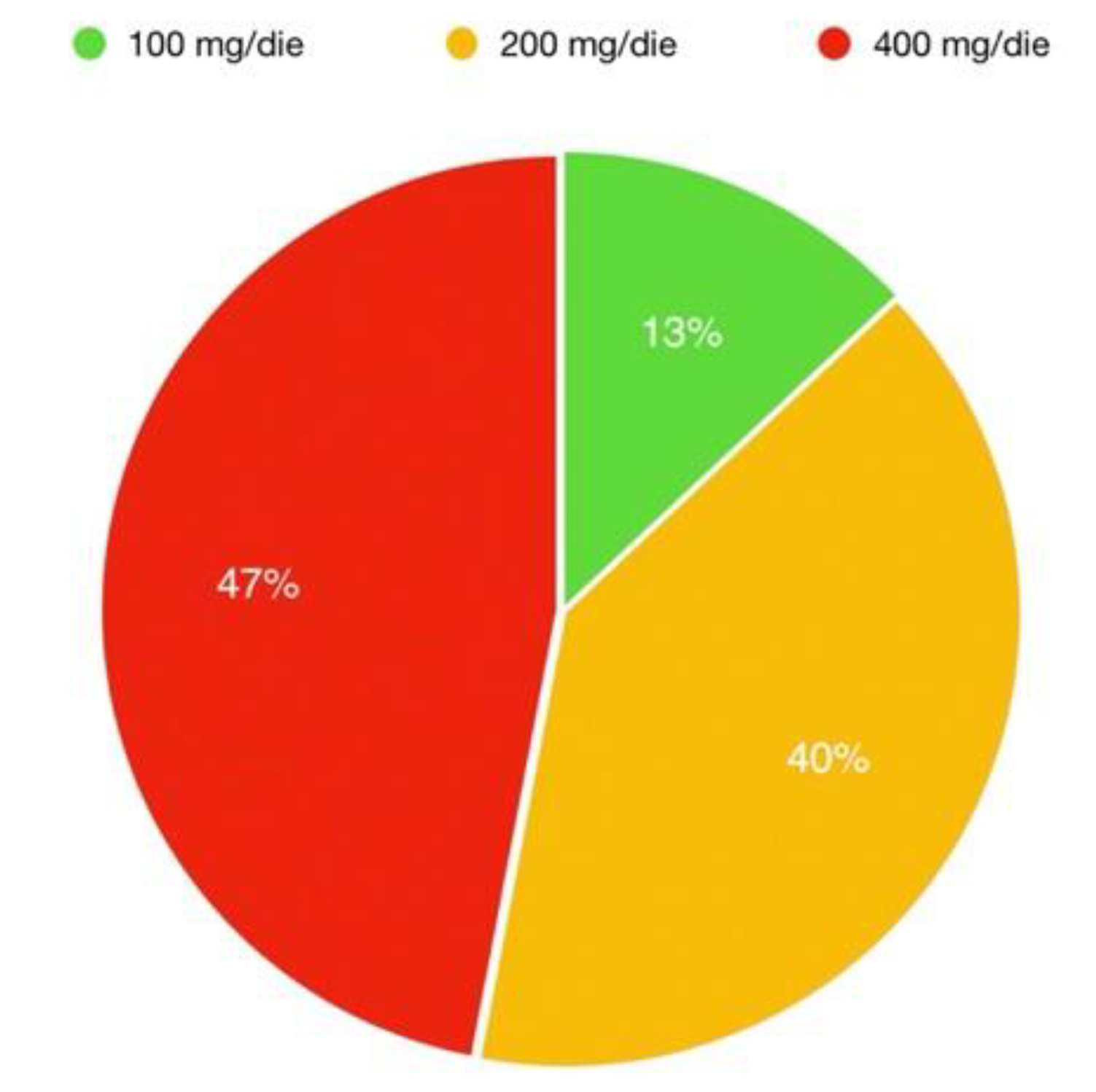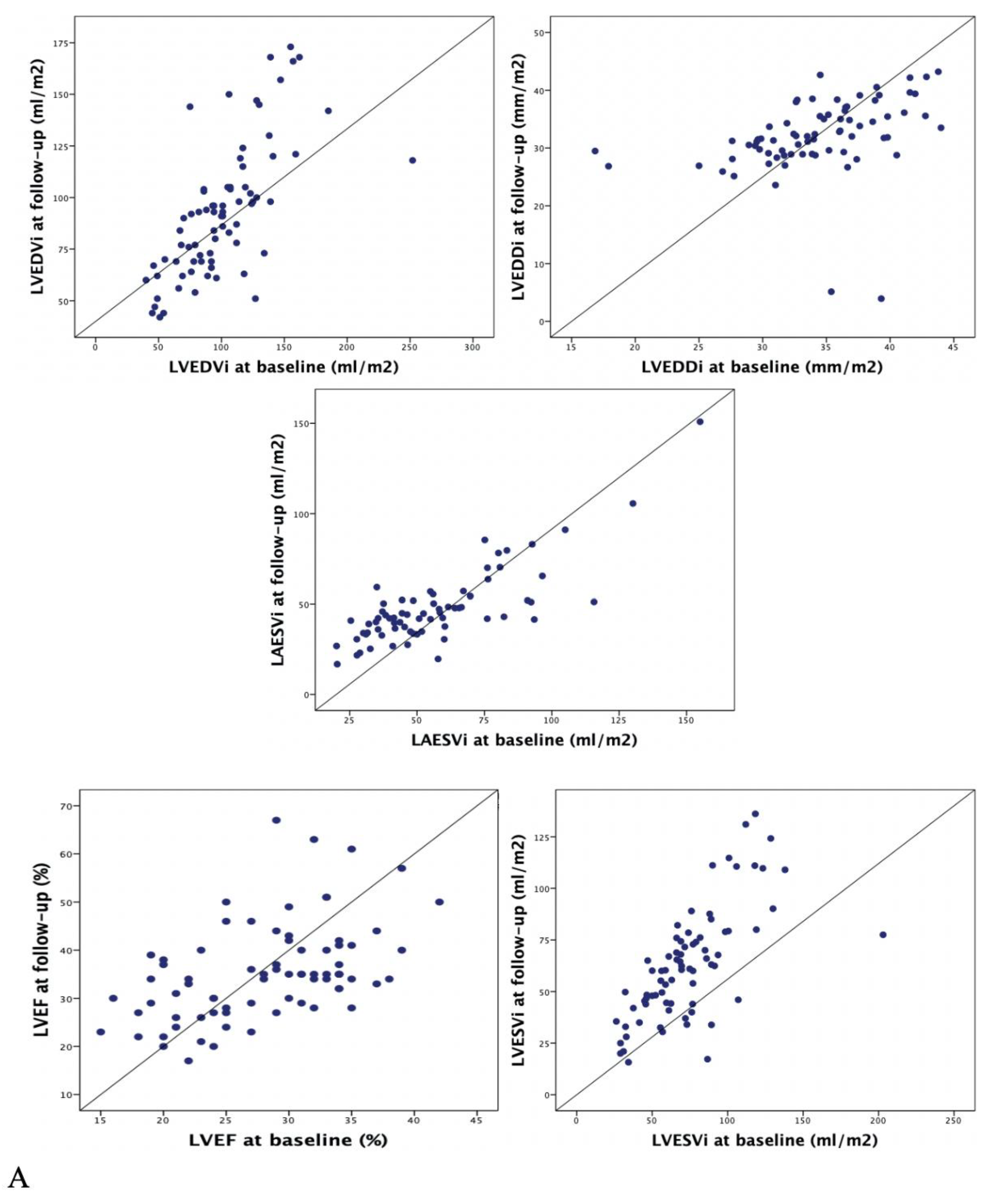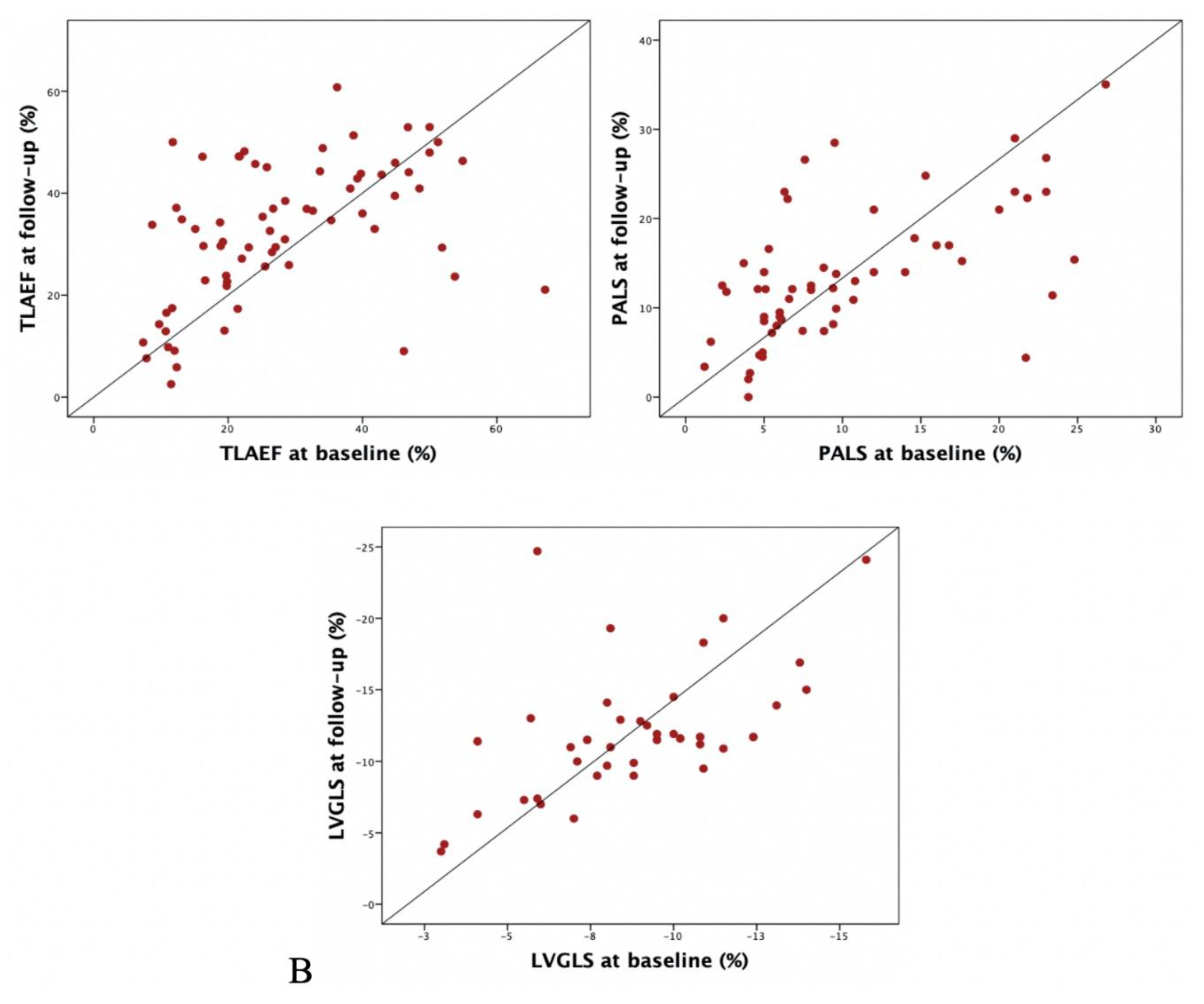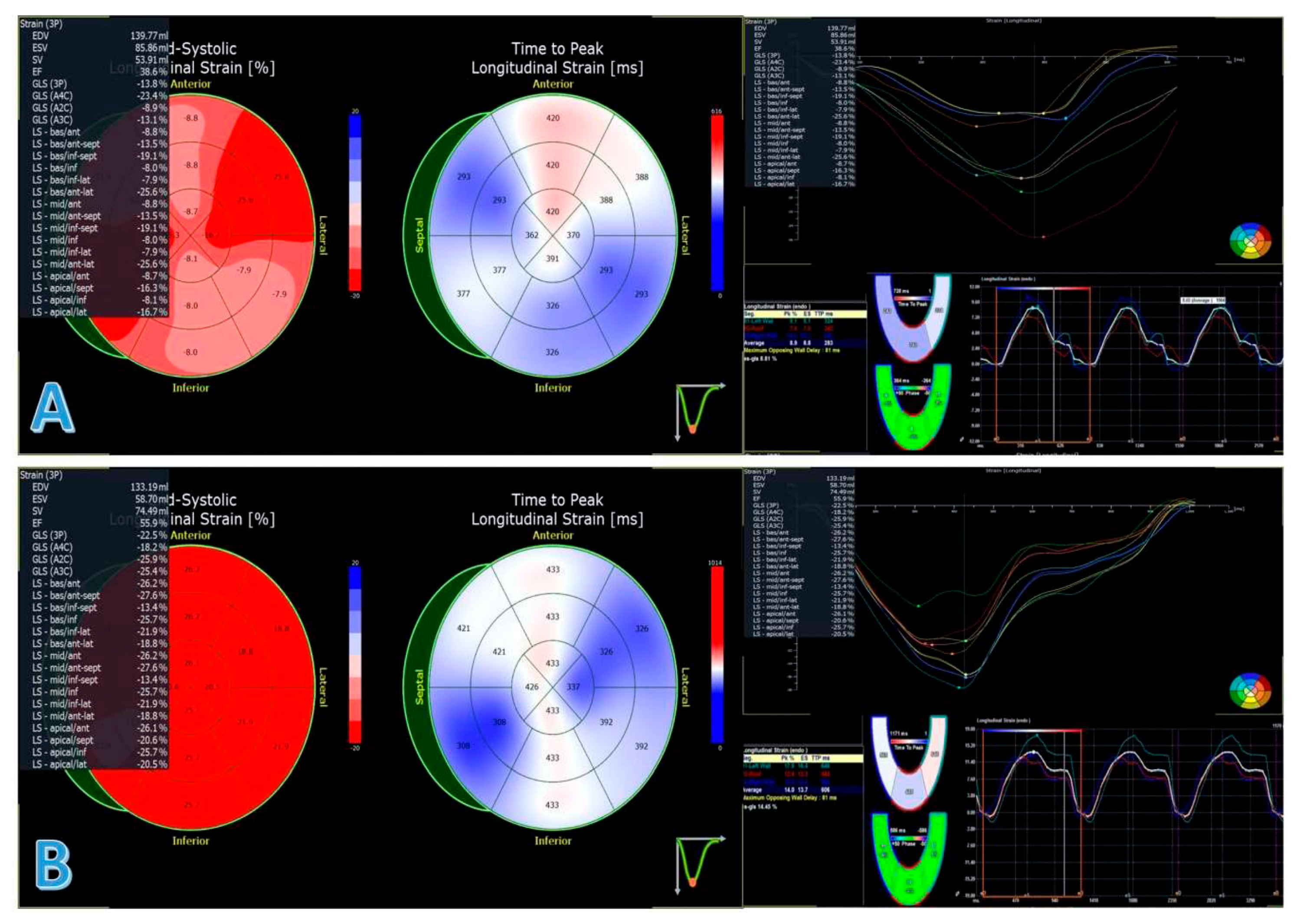Sacubitril/Valsartan Induces Global Cardiac Reverse Remodeling in Long-Lasting Heart Failure with Reduced Ejection Fraction: Standard and Advanced Echocardiographic Evidences
Abstract
1. Introduction
2. Experimental Section
- 1)
- Diagnosis of symptomatic HFrEF (<40%) despite OMT according to ESC guidelines [12].
- 2)
- Availability of a follow-up evaluation at 3 to 18 months including a multi-parametric echocardiographic evaluation. Considering the observational character of our study, the timing of the follow-up evaluation was established by the physician who followed the patient. In case of two echocardiographic evaluations during the follow-up period the last one was considered.
- 3)
- Absence of cardiac resynchronization therapy during the study observation and within 12 months before the enrolment (i.e., introduction of sacubitril/valsartan)
Statistical Analysis
3. Results
4. Discussion
Main Findings
- This is the first report to consider a comprehensive evaluation of LV and LA using both advanced and standard echocardiographic parameters in this setting, documenting that the improvement of both variables was consistent and conferring value to advanced echocardiography
- Finally, the results provided by our study are of particular interest considering the rapid effect showed by sacubitril/valsartan both on LVRR and on LARR despite the long-lasting diseased patients included
Supplementary Materials
Author Contributions
Funding
Acknowledgments
Conflicts of Interest
References
- Burchfield, J.S.; Xie, M.; Hill, J.A. Pathological ventricular remodeling: Mechanisms: Part 1 of 2. Circulation 2013, 128, 388–400. [Google Scholar] [CrossRef]
- Merlo, M.; Pyxaras, S.A.; Pinamonti, B.; Barbati, G.; Di Lenarda, A.; Sinagra, G. Prevalence and prognostic significance of left ventricular reverse remodeling in dilated cardiomyopathy receiving tailored medical treatment. J. Am. Coll. Cardiol. 2011, 57, 1468–1476. [Google Scholar] [CrossRef]
- Matsumori, A. Assessment of Response to Candesartan in Heart Failure in Japan (ARCH-J) Study Investigators. Efficacy and safety of oral candesartan cilexetil in patients with congestive heart failure. Eur. J. Heart Fail 2003, 5, 669–677. [Google Scholar] [CrossRef]
- Cicoira, M.; Zanolla, L.; Rossi, A.; Golia, G.; Franceschini, L.; Brighetti, G.; Marino, P.; Zardini, P. Long-term, dose-dependent effects of spironolactone on left ventricular function and exercise tolerance in patients with chronic heart failure. J. Am. Coll. Cardiol 2002, 40, 304–310. [Google Scholar] [CrossRef]
- Greenberg, B.; Quinones, M.A.; Koilpillai, C.; Limacher, M.; Shindler, D.; Benedict, C.; Shelton, B. Effects of long-term enalapril therapy on cardiac structure and function in patients with left ventricular dysfunction. Results of the SOLVD echocardiography substudy. Circulation 1995, 91, 2573–2581. [Google Scholar] [CrossRef] [PubMed]
- Groenning, B.A.; Nilsson, J.C.; Sondergaard, L.; Fritz-Hansen, T.; Larsson, H.B.; Hildebrandt, P.R. Antiremodeling effects on the left ventricle during beta-blockade with metoprolol in the treatment of chronic heart failure. J. Am. Coll. Cardiol. 2000, 36, 2072–2080. [Google Scholar] [CrossRef]
- McMurray, J.J.V.; Packer, M.; Desai, A.S.; Gong, J.; Lefkowitz, M.P.; Rizkala, A.R.; Rouleau, J.L.; Shi, V.C.; Solomon, S.D.; Swedberg, K.; et al. Angiotensin-neprilysin inhibition versus enalapril in heart failure. N. Engl. J. Med. 2014, 371, 993–1004. [Google Scholar] [CrossRef] [PubMed]
- Diego, C.; Gonzalez-Torres, L.; Nunez, J.M.; Centurion, I.R.; Martin-Langerwerf, D.A.; Sangio, A.D.; Chochowski, P.; Casasnovas, P.; Blazquez, J.C.; Almendral, J. Effects of angiotensin-neprilysin inhibition compared to angiotensin inhibition on ventricular arrhythmias in reduced ejection fraction patients under continuous remote monitoring of implantable defibrillator devices. Heart Rhythm 2018, 15, 395–402. [Google Scholar] [CrossRef]
- Januzzi, J.L.; Prescott, M.F.; Butler, J.; Felker, G.M.; Maisel, A.S.; McCague, K.; Camacho, A.; Piña, I.L.; Rocha, R.A.; Shah, A.M.; et al. PROVE-HF Investigators. Association of Change in N-Terminal Pro-B-Type Natriuretic Peptide Following Initiation of Sacubitril-Valsartan Treatment With Cardiac Structure and Function in Patients With Heart Failure With Reduced Ejection Fraction. JAMA 2019, 1–11. [Google Scholar] [CrossRef]
- Thomas, L.; Abhayaratna, W.P. Left Atrial Reverse Remodeling, Mechanisms, Evaluation, and Clinical Significance. J. Am. Coll. Cardiol 2017, 10. [Google Scholar] [CrossRef]
- Bijl, P.V.D.; Kostyukevich, M.V.; Khidir, M.; Marsan, A.N.; Delgado, V.; Bax, J.J. Left ventricular remodelling and change in left ventricular global longitudinal strain after cardiac resynchronization therapy: Prognostic implications. Eur. Heart. J. Cardiovasc. Imag. 2019, 20, 1112–1119. [Google Scholar] [CrossRef] [PubMed]
- Ponikowski, P.; Voors, A.A.; Anker, S.D.; Bueno, H.; Cleland, J.G.; Coats, A.J.; Falk, V.; González-Juanatey, J.R.; Harjola, V.P.; Jankowska, E.A.; et al. Guidelines for the diagnosis and treatment of acute and chronic heart failure: The Task Force for the diagnosis and treatment of acute and chronic heart failure of the European Society of Cardiology (ESC). Developed with the special contribution of the Heart Failure Association (HFA) of the ESC. Eur. Heart J. 2016, 37, 2129–2200. [Google Scholar] [CrossRef] [PubMed]
- Lang, R.M.; Badano, L.P.; Mor-Avi, V.; Afilalo, J.; Armstrong, A.; Ernande, L.; Flachskampf, F.A.; Foster, E.; Goldstein, S.A.; Kuznetsova, T.; et al. Recommendations for cardiac chamber quantification by echocardiography in adults: An update from the American society of echocardiography and the European association of cardiovascular imaging. Eur. Heart. J. Cardiovasc. Imag. 2015, 16, 233–270. [Google Scholar] [CrossRef] [PubMed]
- Nagueh, S.F.; Smiseth, O.A.; Appleton, C.P.; Byrd, B.F.; Dokainish, H.; Edvardsen, T.; Flachskampf, F.A.; Gillebert, T.C.; Klein, A.L.; Lancellotti, P.; et al. Recommendations for the Evaluation of Left Ventricular Diastolic Function by Echocardiography: An Update from the American Society of Echocardiography and the European Association of Cardiovascular Imaging. J. Am. Soc. Echocardiogr. 2016, 29, 277–314. [Google Scholar] [CrossRef]
- Walter, S.D.; Eliasziw, M.; Donner, A. Sample size and optimal designs for reliability studies. Stat. Med. 1998, 17, 101–110. [Google Scholar] [CrossRef]
- Aimo, A.; Emdin, M.; Maisel, A.S. Sacubitril/Valsartan, Cardiac Fibrosis, and Remodeling in Heart Failure. J. Am. Coll. Cardiol. 2019, 23. [Google Scholar] [CrossRef]
- Pandey, A.C.; Pelter, M.; Montgomery, P.; Kuo, R.; Shen, C.; Sidhu, R.; Lerner, D.; Billick, K.; Hay, B.; Loveday, A.; et al. Changes in Ejection Fraction And Global Longitudinal Strain Assessment In Patients With Heart Failure With Reduced Ejection Fraction After Therapy With Sacubitril/Valsartan. J. Am. Coll. Cardiol. 2019, 9. [Google Scholar] [CrossRef]
- Martens, P.; Beliën, H.; Dupont, M.; Vandervoort, P.; Mullens, W. The reverse remodeling response to sacubitril/valsartan therapy in heart failure with reduced ejection fraction. Cardiovasc. Ther. 2018, 36. [Google Scholar] [CrossRef]
- Merlo, M.; Caiffa, T.; Gobbo, M.; Adamo, L.; Sinagra, G. Reverse remodeling in Dilated Cardiomyopathy: Insights and future perspectives. Int. J. Cardiol. Heart Vasc. 2018, 18, 52–57. [Google Scholar] [CrossRef]
- Solomon, S.D.; McMurray, J.J.V.; Anand, I.S.; Ge, J.; Lam, C.S.P.; Maggioni, A.P.; Martinez, F.; Packer, M.; Pfeffer, M.A.; Pieske, B.; et al. PARAGON-HF Investigators and Committees. Angiotensin-neprilysin inhibition in heart failure with preserved ejection fraction. N. Engl. J. Med 2019. [Google Scholar] [CrossRef]
- Solomon, S.D.; McMurray, J.J.V.; Anand, I.S.; Ge, J.; Lam, C.S.P.; Maggioni, A.P.; Martinez, F.; Packer, M.; Pfeffer, M.A.; Pieske, B.; et al. Early recovery of left ventricular function after revascularization of coronary artery disease detected by myocardial strain. Biomed. Res. 2017, 28, 4. [Google Scholar]
- Martens, P.; Nuyens, D.; Rivero-Ayerza, M.; Van Herendael, H.; Vercammen, J.; Ceyssens, W.; Luwel, E.; Dupont, M.; Mullens, W. Sacubitril/valsartan reduces ventricular arrhythmias in parallel with left ventricular reverse remodeling in heart failure with reduced ejection fraction. Clin. Res. Cardiol. 2019. [Google Scholar] [CrossRef] [PubMed]




| Population N = 77 | Baseline | Follow-Up | p Value |
|---|---|---|---|
| Age (years) | 65 ± 11 | 66 ± 18 | N.C. |
| Male gender, no. % | 60 (77.9) | 60 (77.9) | N.C |
| Caucasian race, no. % | 77 (100) | 77 (100) | N.C. |
| BMI (Kg/m2) | 26.9 ± 3.6 | 27.1 ± 3.7 | N.C. |
| Duration of follow-up (months) | 9 (6–14) | N.A. | N.A. |
| Time since first diagnosis (months) | 76 (28–165) | N.A. | N.A. |
| IHD Etiology, no. % | 31 (40.3) | 31 (40.3) | N.C |
| SBP (mmHg) | 121 ± 13 | 118 ± 15 | 0.088 |
| DBP (mmHg) | 73 ± 8 | 73 ± 8 | 0.903 |
| HR (b/min) | 68 ± 11 | 67 ± 12 | 0.416 |
| NYHA Class, no. % | |||
| I | 0 (0) | 16 (20.8) | |
| II | 59 (76.6) | 53 (68.8) | |
| III | 18 (23.4) | 8 (10.4) | <0.001 |
| IV | 0(0) | 0(0) | |
| COPD, no. % | 13 (16.9) | 13 (16.9) | N.C |
| Diabetes mellitus, no. % | 35 (45.5) | 35 (45.5) | N.C |
| Hypertension, no. % | 42 (54.5) | 42 (54.5) | N.C |
| History of AF, no. % | 29 (37.7) | 29 (37.7) | N.C |
| Creatinine (mg/dL) | 1.2 ± 0.5 | 1.31 ± 0.49 | 0.17 |
| Potassium (mmol/L) | 4.4 ± 0.4 | 4.38 ± 0.45 | 0.99 |
| Beta-blocker, no. % | 72 (93.5) | 74 (96.1%) | 0.71 |
| Beta-blocker bisoprololo dose equivalent (mg) | 3.6 ± 2 | 4 ± 2.7 | 0.18 |
| ACE-i/ARB, no. % | 77 (100) | N.A. | N.A. |
| ACE-i ramipril dose equivalent (mg) | 5.2 ± 3.2 | N.A. | N.A. |
| MRA, no. % | 46 (60) | 48 (65.8) | 0.86 |
| Diuretics, no. % | 66 (85.7) | 63(81.8) | 0.66 |
| Diuretics furosemide dose equivalent dose (mg) | 47 ± 59 | 43 ± 56 | 0.60 |
| Ivabradine, no. % | 10 (13) | 7 (9) | 0.61 |
| ICD, no. % | 53 (68.8) | 53 (68.8) | N.C. |
| CRT, no. % | 23 (23.9) | 23 (23.9) | N.C. |
| Standard Echocardiographic Evaluation | Baseline (N = 77) | Folow-up (N = 77) | p Value |
|---|---|---|---|
| LVEDDi (mm/m2) | 34 ± 5 | 32 ± 7 | 0.006 |
| LVEDVi (mL/m2) | 101 ± 36 | 93 ± 32 | 0.02 |
| LVESVi (mL/m2) | 74 ± 30 | 63 ± 27 | <0.001 |
| LVEF (%) | 28 ± 6 | 35 ± 10 | <0.001 |
| LAESV (mL) | 110 ± 50 | 92 ± 40 | <0.001 |
| LAESVi (mL/m2) | 57 ± 26 | 48 ± 21 | <0.001 |
| RAESA (cm2) | 18 ± 5.5 | 17 ± 5 | 0.011 |
| E/E’ | 16.7 ± 9 | 14.8 ± 7 | 0.11 |
| Restrictive filling pattern no, % | 15 (19.5) | 10(13) | 0.38 |
| MR moderate/severe, N, % | 25 (32.) | 19(24.7) | 0.2 |
| PAPs (mmHg) | 42 ± 19 | 38 ± 17 | 0.122 |
| TAPSE (mm) | 19 ± 4 | 20 ± 5 | 0.72 |
| RVFAC (%) | 42 ± 11 | 42 ± 10 | 0.8 |
| Advanced Echocardiographic Evaluation | BASELINE (N = 77) | Follow-Up (N = 77) | p Value |
|---|---|---|---|
| LVGLS (%) | −8.3 ± 4 | −12 ± 4.7 | <0.001 |
| TLAEF (%) | 28.2 ± 14.2 | 32.6 ± 13.6 | 0.013 |
| PALS (%) | 10.3 ± 6.9 | 13.7 ± 7.6 | <0.001 |
| LVRR (N = 20) | No LVRR (N = 57) | OR (95% C.I.) | p Value | |
|---|---|---|---|---|
| Male sex, no. (%) | 14 (70%) | 45 (80%) | 1.753 (0.549–5.601) | 0.343 |
| Age (years) | 69 ± 11 | 64 ± 11 | 1.038 (0.987–1.091) | 0.147 |
| Duration of the disease (months) | 28 (9–90) | 99 (35–221) | 0.988 (0.980–0.997) | 0.010 |
| Follow up (months) | 8 (6-11) | 10 (6–15) | 0.948 (0.859–1.047) | 0.291 |
| HR (bpm) | 66.8 ± 11 | 68.3 ± 11 | 0.987 (0.940–1.035) | 0.585 |
| SBP (mmHg) | 125 ± 11 | 119 ± 13 | 1.038 (0.998–1.080) | 0.063 |
| DBP (mmHg) | 73 ± 8 | 72.7 ± 8 | 1.005 (0.942–1.071) | 0.890 |
| COPD, no. (%) | 3 (15%) | 10 (18%) | 0.812 (0.199–3.308) | 0.771 |
| Diabetes mellitus, no. (%) | 6 (30%) | 28 (49%) | 0.429 (0.144–1.275) | 0.128 |
| Hypertension, no. (%) | 10 (50%) | 25 (44%) | 0.806 (0.290–2.24) | 0.680 |
| IHD, no. (%) | 5 (25%) | 25 (44%) | 2.419 (0.773–7.573) | 0.129 |
| NYHA Class (average) | 2.15 ± 0.366 | 2.26 ± 0.442 | 0.504 (0.128–1.984) | 0.327 |
| History of AF, no. (%) | 8 (40%) | 21 (37%) | 1.111 (0.391–3.161) | 0.843 |
| Creatinine (mg/dL) | 1.02 ± 0.43 | 1.26 ± 0.5 | 0.197 (0.027–1.440) | 0.109 |
| ACE-I/ARB (Ramipril dose equivalent), mg | 5.6 ± 3 | 4.98 ± 3.3 | 1.054 (0.904–1.228) | 0.503 |
| Beta-blockers, no. (%) | 19 (95%) | 52 (93%) | 1.462 (0.154–1.914) | 0.741 |
| Beta-blockers (bisoprolol dose equivalent), mg | 3.25 ± 2.2 | 3.64 ± 2.4 | 0.928 (0.738–1.168) | 0.526 |
| Sacubitril/Valsartan full dose, no. (%) | 12 (60%) | 23 (41%) | 2.152 (0.760–6.095) | 0.149 |
| MRA, no. (%) | 11 (55%) | 35 (62%) | 0.733 (0.261–2.062) | 0.557 |
| Diuretics, no. (%) | 17 (85%) | 48 (85%) | 0.944 (0.224–3.977) | 0.938 |
| Diuretics (furosemide dose equivalent), mg | 55 ± 28 | 44 ± 25 | 1.003 (0.995–1.011) | 0.488 |
| Ivabradine, no. (%) | 2 (10%) | 8 (14%) | 0.667 (0.129–3.442) | 0.628 |
| CRT, no. (%) | 5 (20%) | 18 (32%) | 0.704 (0.221–2.238) | 0.552 |
| LVEF (%) | 27 ± 6 | 28 ± 6 | 0.979 (0.901–1.063) | 0.606 |
| LVEDVi (mL/m2) | 99 ± 47 | 101 ± 32 | 0.998 (0.984–1.013) | 0.785 |
| LVESVi (mL/m2) | 72.5 ± 40 | 74 ± 26 | 0.998 (0.981–1.015) | 0.808 |
| LAESV (mL) | 106 ± 48 | 111 ± 50 | 0.998 (0.987–1.009) | 0.719 |
| RAESA (cm2) | 18.4 ± 4.9 | 18.2 ± 5.4 | 1.007 (0.911–1.114) | 0.890 |
| E/E’ | 14.6 ± 5.2 | 17 ± 9.8 | 0.965 (0.897–1.038) | 0.341 |
| Restrictive pattern, no. (%) | 3 (14%) | 14 (25%) | 0.418 (0.083–2.089) | 0.288 |
| RVFAC (%) | 42 ± 14 | 38 ± 12 | 1.023 (0.969–1.080) | 0.416 |
| TAPSE (mm) | 20 ± 5.8 | 19 ± 5,9 | 1.027 (0.925–1.141) | 0.612 |
| PAPs (mmHg) | 37 ± 15 | 44 ± 18 | 0.975 (0.935–1.017) | 0.233 |
© 2020 by the authors. Licensee MDPI, Basel, Switzerland. This article is an open access article distributed under the terms and conditions of the Creative Commons Attribution (CC BY) license (http://creativecommons.org/licenses/by/4.0/).
Share and Cite
Castrichini, M.; Manca, P.; Nuzzi, V.; Barbati, G.; De Luca, A.; Korcova, R.; Stolfo, D.; Di Lenarda, A.; Merlo, M.; Sinagra, G. Sacubitril/Valsartan Induces Global Cardiac Reverse Remodeling in Long-Lasting Heart Failure with Reduced Ejection Fraction: Standard and Advanced Echocardiographic Evidences. J. Clin. Med. 2020, 9, 906. https://doi.org/10.3390/jcm9040906
Castrichini M, Manca P, Nuzzi V, Barbati G, De Luca A, Korcova R, Stolfo D, Di Lenarda A, Merlo M, Sinagra G. Sacubitril/Valsartan Induces Global Cardiac Reverse Remodeling in Long-Lasting Heart Failure with Reduced Ejection Fraction: Standard and Advanced Echocardiographic Evidences. Journal of Clinical Medicine. 2020; 9(4):906. https://doi.org/10.3390/jcm9040906
Chicago/Turabian StyleCastrichini, Matteo, Paolo Manca, Vincenzo Nuzzi, Giulia Barbati, Antonio De Luca, Renata Korcova, Davide Stolfo, Andrea Di Lenarda, Marco Merlo, and Gianfranco Sinagra. 2020. "Sacubitril/Valsartan Induces Global Cardiac Reverse Remodeling in Long-Lasting Heart Failure with Reduced Ejection Fraction: Standard and Advanced Echocardiographic Evidences" Journal of Clinical Medicine 9, no. 4: 906. https://doi.org/10.3390/jcm9040906
APA StyleCastrichini, M., Manca, P., Nuzzi, V., Barbati, G., De Luca, A., Korcova, R., Stolfo, D., Di Lenarda, A., Merlo, M., & Sinagra, G. (2020). Sacubitril/Valsartan Induces Global Cardiac Reverse Remodeling in Long-Lasting Heart Failure with Reduced Ejection Fraction: Standard and Advanced Echocardiographic Evidences. Journal of Clinical Medicine, 9(4), 906. https://doi.org/10.3390/jcm9040906





